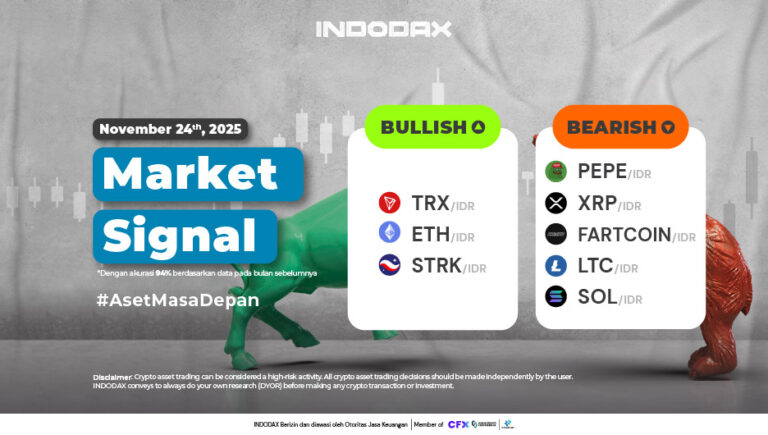Bank stocks are an attractive choice for investors because of their role as the backbone of the economy, both in stable and challenging market conditions.
In 2025, the banking sector is predicted to continue to grow thanks to technological innovation and supportive economic policies.
Therefore, understanding the types of bank stocks, from large banks to regional banks, is important for investors to make the right decisions.
This article aims to provide guidance for novice traders and investors to take advantage of opportunities in the bank stock sector, understand its characteristics, and implement effective investment strategies.
Getting to Know Bank Stocks: What Do You Need to Know?

Bank stocks are one of the attractive investment instruments because of their vital role in the economy. As financial service providers, banks support various business activities and individual needs.
Here is a complete explanation of what bank stocks are, their role, and the categories of banks that you need to understand before investing.
Basically, bank stocks are stocks that represent ownership in banking institutions, such as JPMorgan Chase, Wells Fargo, and Bank of America. Bank stocks can be categorized in several ways, such as the size of the bank or the main focus of its business.
Bank Categories
Below are some categories of banks that you need to know, as quoted from the nerdwallet.com page, namely:
1.National Banks
National banks are large financial institutions that manage more than $100,000,000,000 in assets and usually have operations throughout the United States.
Examples include JPMorgan Chase, Bank of America, and Citigroup, which also often have investment, commercial, and retail divisions.
2.Regional and Community Banks
Regional Banks: Manage assets between $10,000,000,000 and $100,000,000,000, with operations limited to a specific region, such as a few states or a specific geographic area.
Community Banks: Manage assets of less than $10,000,000,000 and usually operate in one metro area or part of a state, serving the needs of the local community.
3.Investment Banks vs Commercial Banks vs Retail Banks
1.Investment Banks
Investment banks serve public companies, governments, and other large institutions. Their services include wealth management, corporate mergers, and initial public offerings (IPOs). Investment banks’ performance is often tied to the stock market.
2.Commercial Banks
Commercial banks serve small to mid-sized businesses, providing services such as business accounts and loans.
Their performance is dependent on interest rates, which can increase profit margins on loans, as well as the strength of the overall economy.
3.Retail Banks
Retail banks focus on individuals, offering services such as savings and checking accounts, credit cards, and personal financial advice. Like commercial banks, their performance is also affected by interest rates and economic conditions.
Also Read: 8 Differences Between Nasdaq and NYSE: Choose Smartly, Gain Profit!
Bank of America (BAC) Stock: A Case Study of a Major Bank Stock
Bank of America (BAC) stock is traded on the New York Stock Exchange (NYSE) under the ticker symbol “BAC.”
The stock is one of the leading stocks in the banking sector, reflecting Bank of America’s position as one of the largest financial institutions in the world.
Bank of America Investment Features
1.Direct Investment Plan
Bank of America offers a direct investment program through the Bank of America Corporation Investment Plan.
This program allows investors to purchase their first shares directly without going through a broker, making it a simpler and more cost-effective investment method.
2.Dividend Reinvestment
The Dividend Reinvestment Plan offers a variety of services that make it easy for investors to reinvest dividends received and buy and sell Bank of America shares at a low cost.
BAC Stock Performance
Quoting the id.investing.com page, Bank of America (BAC) shares were traded on the NYSE at a final price of $46.21 (+0.28%) at the closing session, and fell slightly to $46.15 (-0.13%) in after-hours trading.
In the daily range, BAC’s stock price moved between $45.69 and $46.26, while in the 52-week range, the stock was traded between $31.27 and $48.08, indicating moderate volatility.
In terms of valuation, BAC’s P/E ratio is at 16.64, while the Price/Book ratio is recorded at 1.31, reflecting a relatively reasonable valuation compared to similar industries.
A dividend yield of 1.98% provides additional appeal for investors seeking passive income.
In recent years, Bank of America’s financial performance has shown stability, with total revenue reaching $95.787 million in 2023 and net income of $26.515 million.
However, this trend also shows a slowdown in growth compared to previous years. Analysts give a consensus of “Buy” with an average 12-month price target of $50.85, which reflects a potential upside of 10.03% from the current price.
With solid fundamentals and promising long-term prospects, BAC stock remains an attractive choice for investors despite considering market volatility and global economic factors.
Best Performing Bank Stocks in 2025
2025 is an interesting period for the banking sector, with several bank stocks posting extraordinary performance. Here is a list of the best bank stocks based on S&P 500 index data, as well as the factors that drive their achievements.
Also Read: What is the S&P 500? A Complete Beginner’s Guide to Investing!
List of Best Bank Stocks
Based on data from the S&P 500 index, as quoted from nerdwallet.com, here are the seven best performing bank stocks in the past year:
Wells Fargo & Co (WFC): Increase 46.49%
M&T Bank Corp (MTB): Increase 42.31%
JPMorgan Chase & Co (JPM): Increase 41.99%
Citizens Financial Group Inc (CFG): Increase 38.64%
Bank of America Corp (BAC): Increase 33.64%
Citigroup Inc (C): Increase 32.36%
Huntington Bancshares, Inc (HBAN): Increase 31.39%
Note: The above data reflects performance through January 3, 2025, and is designed for informational purposes, not for trading purposes.
Performance Drivers
It is worth noting that the above stocks outperformed due to the following key factors:
- Rising Interest Rates: The higher interest rate environment has increased profit margins on loans, providing a boost to bank earnings.
- Banking Technology Innovation: Major banks continue to invest in technology, such as digital services and automation, which helps improve operational efficiency and competitiveness.
- Strong Economic Conditions: Steady economic recovery supports increased demand for banking services, including business and consumer lending.
Advantages and Disadvantages of Bank Stock Investment
Bank stock investment can be an attractive option, especially when interest rates are high. However, bank stock investment also has advantages and disadvantages that need to be understood before deciding to invest. Here are some of them:
Advantages
1.Potential for higher profits when interest rates rise
Commercial and retail banks tend to benefit from rising interest rates. Most of their income comes from lending activities, so higher interest rates can increase income from loan interest.
2.Stability of the large banking sector
Most large banks consistently pay dividends to investors. These dividends are considered an indicator of good financial health, so bank stocks often provide stable passive income for investors.
Disadvantages
1.Regulatory risk
After the 2008 financial crisis, regulations on banks have become stricter, such as through the Dodd-Frank Act.
This regulation allows authorities such as the Federal Reserve to limit dividend increases and share buybacks during times of financial stress, such as the 2020 recession.
2.Dependence on global economic conditions
Investment banks are highly dependent on the performance of the stock market and the global economy. When markets decline or companies tighten spending, investment banks’ revenues can drop dramatically.
In addition, some large banks have controversial clients such as fossil fuel or arms companies, which can be a challenge for investors concerned with ethical values.
Also Read: How to Buy IPO Stocks, A Practical Guide for Beginners
How to Buy Bank Stocks
If you are interested in buying bank stocks, there are a few steps you need to follow. Here is a quick guide to start investing in bank stocks.
Steps to Buy Bank Stocks
1.Open a brokerage account
The first step to buying bank stocks is to open a brokerage account. This account allows you to buy various types of investments, including bank stocks.
2.Buy stocks directly from an investment plan
The next step is that you can also choose to buy bank stocks directly.
Individual stocks from certain banks can provide great profit potential, but also have high risks, especially if management decisions are bad or there is a regional economic downturn.
3.Investing through ETFs that focus on the banking sector
Another alternative is to buy ETFs (Exchange-Traded Funds) that focus on banks and other financial institutions. ETFs help you invest in a basket of stocks, making it more diversified than buying individual stocks.
Tips for Beginners
To reduce risk, experts recommend that individual stocks only make up about 10% of your total portfolio.
Diversifying with broader investments, such as ETFs or S&P 500 index funds, can also help mitigate the impact of losses from a particular stock.
Also Read: Top 7 American Blue Chip Stocks with the Biggest Dividends
Technical and Fundamental Analysis of Bank Shares

To understand the potential of bank stocks, you need to conduct technical and fundamental analysis. These two approaches provide different, but complementary, insights.
Technical Analysis
Technical analysis focuses on stock price movements and trading volume to predict the direction of future price movements.
Some technical indicators that are often used in analyzing bank stocks, such as Bank of America (BAC), include:
1.Moving Averages (MA)
Moving averages are used to identify stock price trends. For example, if the BAC stock price is above the 50-day moving average, it could be a signal that the price trend is rising.
Conversely, if the stock price is below the moving average, it could indicate a downward trend.
2.Relative Strength Index (RSI)
It should be noted that the RSI is a momentum indicator that measures the speed and change in price movements.
An RSI above 70 indicates that BAC shares may be overbought, while below 30 indicates oversold conditions, which could be a signal of a price reversal.
3.Moving Average Convergence Divergence (MACD)
MACD is used to identify trend changes. If the MACD for BAC shows a positive crossover (the MACD line crosses the signal line from bottom to top) then this could be a buy signal.
However, conversely, a negative crossover (the MACD line crosses the signal line from top to bottom) could be a sell signal.
Fundamental Analysis
Fundamental analysis focuses on a company’s financial performance to determine the intrinsic value of a stock. Some important financial ratios for bank stocks like BAC include:
1.Price-to-Earnings Ratio (P/E)
The P/E ratio is used to assess stock valuation. For example, if the P/E for BAC is higher than the industry average then it could indicate that the stock is overvalued or that investors are expecting higher growth in the future.
2.Dividend Yield
The dividend yield shows how much dividends a bank pays compared to its stock price.
If BAC has a high dividend yield then this could be attractive to investors looking for passive income.
However, very high dividends are also worth noting as they could indicate greater risk if the company faces financial difficulties.
Conclusion
Well, that was an interesting discussion about Smart Ways to Invest in Bank America (BAC) Stocks that you can read in full at the Crypto Academy at INDODAX Academy. Not only does it increase your insight into investment, here you can also find the latest crypto news about the crypto world.
In addition, find the latest information about the most complete collection of crypto articles from Indodax Academy. Don’t miss the opportunity to expand your knowledge in the world of investment and digital technology!
In conclusion, bank stocks offer attractive profit potential, especially in high interest rate conditions, but they also have risks that need to be considered.
If you want to start investing, you can choose between buying individual bank stocks or investing through ETFs that focus on the banking sector.
In addition, it is also important to conduct technical analysis using indicators such as moving averages, RSI, and MACD and conduct fundamental analysis by evaluating financial ratios such as P/E and dividend yield.
Furthermore, never hesitate to start your investment journey. Do in-depth research before buying bank stocks and take advantage of platforms like INDODAX Academy to learn more about smart and safe investments.
For additional information, INDODAX will launch a new feature that allows users to invest in stocks listed on the United States stock market.
Through this feature, users can expand their portfolio with more than 50 US stocks, as well as crypto assets, all of which can be managed through one integrated account on the INDODAX platform.
FAQ
1.What are bank stocks?
Bank stocks are shares of ownership in a banking company that can be traded on the stock market.
2.Why is Bank of America attractive?
Because it is stable, has consistent dividends, and uses technology to improve services.
3.What are the main risks of investing in bank stocks?
Regulatory risk, global economic conditions, and market volatility.
4.How do I start investing in bank stocks?
Open a brokerage account, do research, buy stocks, and monitor investments.
5.What is the difference between national, regional, and community banks?
National banks operate broadly, regional banks focus on a specific area, and community banks serve local areas.





 Polkadot 8.91%
Polkadot 8.91%
 BNB 0.45%
BNB 0.45%
 Solana 4.80%
Solana 4.80%
 Ethereum 2.37%
Ethereum 2.37%
 Cardano 1.65%
Cardano 1.65%
 Polygon Ecosystem Token 2.13%
Polygon Ecosystem Token 2.13%
 Tron 2.85%
Tron 2.85%
 Market
Market


